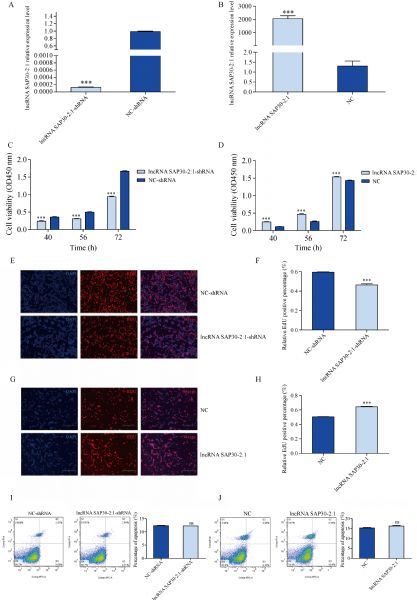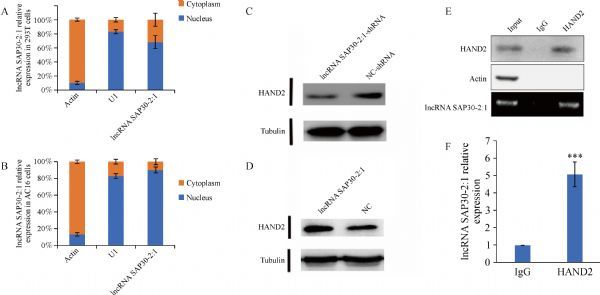Among the differentially expressed lncRNAs, we focused on lncRNA SAP30-2:1 because it is a novel lncRNA with a relative higher foldchange in fetal heart compared with the adult group according to RNA-seq analysis, and bioinformatics analysis predicted that its target gene could be
HAND2, an important transcription factor related to CHD. lncRNA SAP30-2:1 was downregulated in injured heart tissue from CHD patients. We therefore carried out
in vitro experiments to clarify the molecular mechanism underlying this clinical phenomenon. However, no human myocardial cell lines were available, and lncRNA-SAP30-2:1 has no homologous sequence in mice. Thus, we used the tool cell line HEK293T, in line with previous research on CHD and human heart development [
23–
25]. A part of
in vitro experiments was repeated using AC16, a cell line similar to human cardiomyocytes. Cell experiments showed that lncRNA SAP30-2:1 was mainly located in the nuclei. lncRNAs located in the nucleus play a regulatory role as either cis-acting or trans-acting factors [
26]. Low-expression lncRNA SAP30-2:1 downregulated HAND2 protein expression by binding to it, whereas the knockdown of lncRNA SAP30-2:1 significantly inhibited HEK293T and AC16 cell proliferation. HAND2 regulates the development of cardiovascular structures and acts as a transcription factor to control cardiomyocyte production [
27,
28]. Furthermore, mutations or abnormal expression of
HAND2 can increase the risk of CHD [
29–
32], whereas non-coding transcripts influence heart development by targeting
HAND2 [
33,
34]. Cardiogenesis is a complex developmental process including cell proliferation and contributes to cardiac growth and regeneration [
35,
36]; HAND2 also plays critical regulatory roles in cardiomyocyte proliferation [
30]. The relationship between the novel non-coding transcript lncRNA SAP30-2:1 and CHD may be as follows: lncRNA SAP30-2:1 may positively regulate the expression level of HAND2, the molecular mediator of CHD, by joining with it to affect cell proliferation. Thus, lncRNA SAP30-2:1 may be involved in the process of cardiogenesis. However, the detailed mechanisms by which lncRNA SAP30-2:1 modulates cardiac development and its function require further studies.







